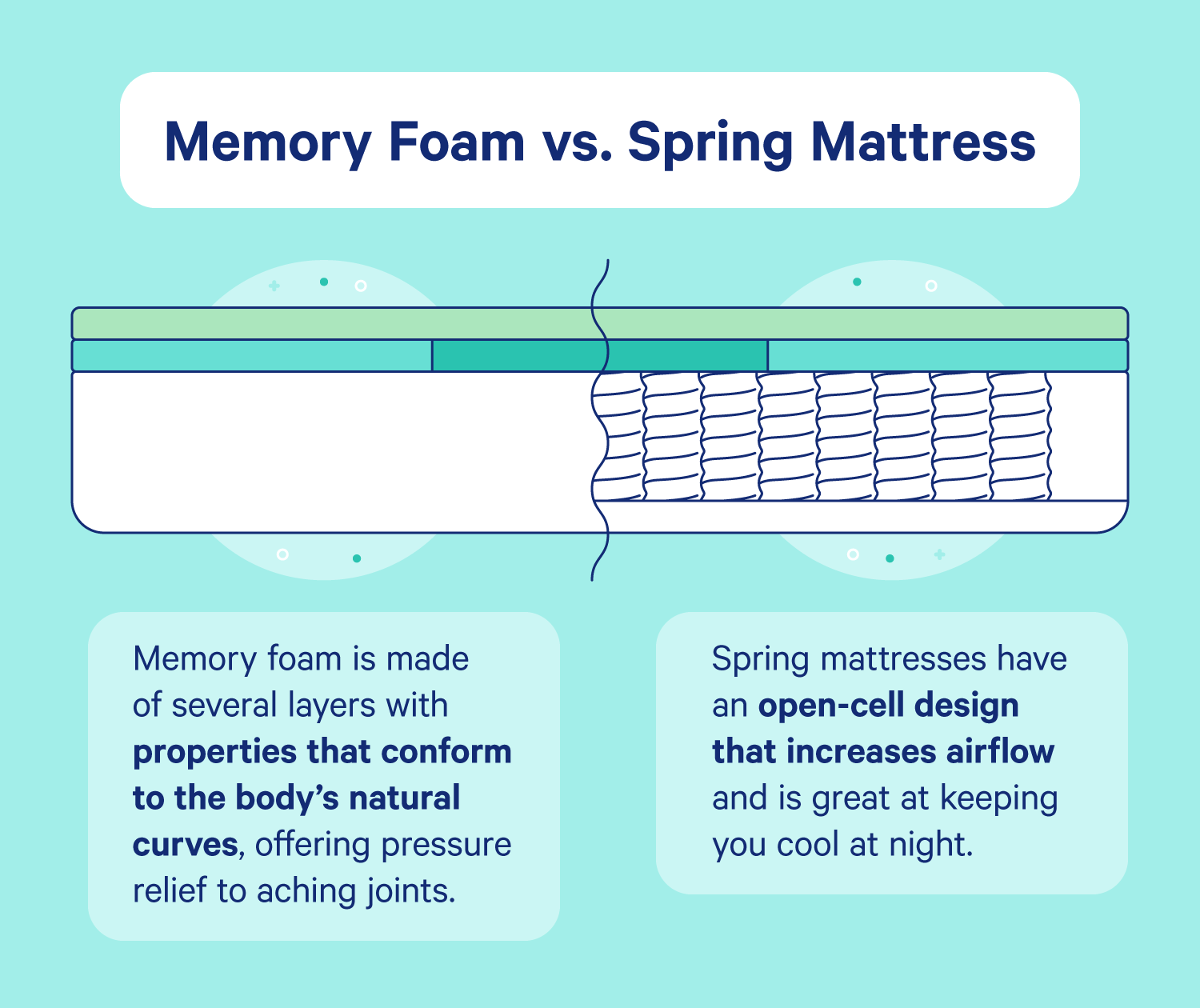When it comes to getting a good night’s sleep, choosing the right mattress is essential. With so many options available, it can be overwhelming to decide which one is best for you. In this article, we will be decoding two popular mattress types: memory foam and spring mattresses. So, whether you’re sinking into the comfort of memory foam or bouncing on the springs of a traditional mattress, we’ll help you understand the key differences and make an informed decision. Let’s dive in!
Memory foam mattresses have gained immense popularity in recent years, and for good reason. The unique material contours to your body, providing personalized support and pressure relief. Imagine sinking into a cloud as the memory foam gently cradles you throughout the night. It’s like sleeping on a fluffy marshmallow! On the other hand, spring mattresses have been around for ages and are known for their bouncy feel. The coil springs inside the mattress offer a responsive surface, providing a traditional and familiar sleep experience. It’s like bouncing on a trampoline, but in the coziest way possible.
In this article, we will explore the pros and cons of memory foam and spring mattresses, helping you determine which one suits your sleep preferences and needs. So, get ready to unlock the secrets of these mattress types and make an informed choice for a restful night’s sleep!
Decoding Mattress Types: Memory Foam vs Spring
When it comes to choosing a mattress, two popular options to consider are memory foam and spring mattresses. Each type has its own unique benefits. Memory foam mattresses provide excellent support by contouring to your body’s shape, relieving pressure points, and reducing motion transfer. On the other hand, spring mattresses offer a more traditional and bouncy feel, with great breathability and edge support. To help you decide, here’s a comparison table:
| Memory Foam | Spring |
|---|---|
| Conforms to body shape | Bouncy and responsive |
| Pressure relief | Great breathability |
| Minimal motion transfer | Edge support |
Consider your preferences and needs for support, comfort, and sleep quality when choosing between memory foam and spring mattresses. Both options have their merits, so it’s important to find the one that suits you best.

Decoding Mattress Types: Memory Foam vs Spring
Deciding on the right mattress can be a daunting task, especially with the wide variety of options available in the market. Two popular choices that often come up in the search for the perfect mattress are memory foam and spring mattresses. Both offer unique features and benefits that cater to different sleep preferences. In this article, we will decode the key differences between memory foam and spring mattresses, helping you make an informed decision.
Memory Foam Mattresses: A Blissful Night’s Sleep
Memory foam mattresses have gained significant popularity in recent years, and for good reason. Made from a viscoelastic material, memory foam molds to the shape of your body, providing excellent support and pressure relief. As you lie down, the foam responds to your body heat, softening and contouring to your curves. This personalized support helps align your spine, reducing the risk of back pain and promoting a restful sleep.
One of the standout features of memory foam mattresses is their ability to isolate motion transfer. This means that when your partner moves or gets out of bed, you won’t feel the motion on your side, allowing for uninterrupted sleep. This is particularly beneficial for couples or light sleepers who are easily disturbed by movement.
Memory foam mattresses also excel in providing a comfortable sleep surface that adapts to your body’s temperature. The foam’s heat retention properties allow it to absorb and retain warmth, creating a cozy and cozy environment for a good night’s sleep, especially during colder months.
The Benefits of Memory Foam Mattresses
1. Pressure Relief: The unique contouring properties of memory foam relieve pressure points, reducing the likelihood of waking up with aches and pains.
2. Motion Isolation: Memory foam mattresses absorb and minimize motion transfer, ensuring a peaceful sleep for couples.
3. Spine Alignment: The adaptive nature of memory foam helps align the spine, promoting proper posture and reducing back pain.
4. Temperature Regulation: Memory foam retains body heat, creating a warm and comfortable sleep surface for chilly nights.
5. Hypoallergenic: Memory foam mattresses are resistant to allergens such as dust mites, making them a great choice for allergy sufferers.
Spring Mattresses: A Classic Choice
Spring mattresses, also known as innerspring mattresses, have been a popular choice for decades. These mattresses feature a support system of metal coils or springs, which provide a firm and supportive sleep surface. The coils are typically topped with layers of cushioning materials such as foam or fiber to enhance comfort.
One of the key advantages of spring mattresses is their responsiveness and bounce. The coils offer a springy feel, making it easier to move around and change positions during sleep. This can be especially beneficial for individuals who tend to feel trapped or restricted on memory foam mattresses.
Additionally, spring mattresses are well-known for their breathability. The open structure of the coil system allows for excellent airflow and heat dissipation, preventing the mattress from trapping excessive heat. This makes them a suitable choice for hot sleepers or those living in warmer climates.
The Benefits of Spring Mattresses
1. Responsiveness: The springy feel of a spring mattress allows for easy movement and changing positions during sleep.
2. Breathability: The open structure of the coil system promotes airflow, preventing the mattress from trapping heat.
3. Durability: High-quality spring mattresses are known for their longevity, providing years of comfortable sleep.
4. Edge Support: Spring mattresses often feature reinforced edges, providing better support and preventing sagging.
5. Affordability: Spring mattresses are generally more budget-friendly compared to memory foam mattresses.
In conclusion, both memory foam and spring mattresses offer unique benefits that cater to different sleep preferences. Memory foam mattresses excel in providing personalized support, pressure relief, and motion isolation, making them an excellent choice for individuals seeking a contouring and cozy sleep surface. On the other hand, spring mattresses offer responsiveness, breathability, and affordability, making them a classic and budget-friendly option. Ultimately, the choice between the two comes down to personal preference and individual sleep needs.
Key Takeaways: Decoding Mattress Types: Memory Foam vs Spring
- Memory Foam Mattresses: These mattresses are known for their ability to contour to your body, providing excellent pressure relief and support.
- Spring Mattresses: These mattresses use a system of metal coils to provide support and bounce, making them a popular choice for those who prefer a more traditional feel.
- Comfort and Feel: Memory foam mattresses offer a plush, sink-in feel, while spring mattresses provide a firmer, bouncier feel.
- Temperature Regulation: Memory foam mattresses tend to retain more heat, while spring mattresses offer better airflow and cooling.
- Durability and Longevity: Memory foam mattresses are typically more durable and have a longer lifespan compared to spring mattresses.
Frequently Asked Questions
What is the difference between memory foam and spring mattresses?
Memory foam mattresses and spring mattresses are two popular options in the market today. The main difference between these two types lies in the materials used and the way they provide support and comfort.
Memory foam mattresses are made from a high-density foam that contours to the shape of your body. This allows for better pressure relief and support, relieving aches and pains. On the other hand, spring mattresses have a network of coils that provide support and bounce. These coils can vary in thickness and density, affecting the overall feel of the mattress.
Which type of mattress is better for back pain: memory foam or spring?
Both memory foam and spring mattresses can provide relief for back pain, but it depends on individual preferences and needs. Memory foam mattresses are often recommended for those with back pain as they conform to the body’s contours and provide even support. This can help alleviate pressure points and reduce discomfort.
Spring mattresses, on the other hand, offer a more traditional feel with bounce and responsiveness. Some individuals find that the support and firmness of a spring mattress can help with their back pain. Ultimately, it’s important to try out different mattresses and determine which one feels most comfortable and supportive for your back.
Are memory foam mattresses hot to sleep on?
One common concern with memory foam mattresses is their tendency to retain heat. However, advancements in technology have led to the development of cooling gel-infused memory foam and breathable cover materials that help regulate temperature.
While memory foam mattresses can still retain some heat, many manufacturers now prioritize temperature regulation and provide options that cater to those who sleep hot. It’s important to research and choose a memory foam mattress with cooling features if you are sensitive to heat.
Do spring mattresses last longer than memory foam mattresses?
When it comes to the lifespan of a mattress, both spring and memory foam mattresses can offer durability. However, there are some factors to consider that may affect their longevity.
Spring mattresses tend to have a longer lifespan due to the nature of their construction. The coils in a spring mattress provide additional support and can withstand more weight over time. Memory foam mattresses, while they can also last for many years, may experience some compression and softening with prolonged use. It’s important to choose a high-quality mattress and properly care for it to ensure its longevity.
Which type of mattress is better for motion isolation: memory foam or spring?
Memory foam mattresses are known for their excellent motion isolation properties. The viscoelastic foam absorbs movement and prevents it from transferring across the mattress. This can be beneficial for couples or individuals who are easily disturbed by their partner’s movements during sleep.
Spring mattresses, on the other hand, tend to have more motion transfer due to the interconnected coils. When one person moves, the entire mattress can be affected. However, some spring mattresses now come with individually pocketed coils that help minimize motion transfer. It’s important to consider your specific needs and preferences when it comes to motion isolation.

Innerspring Vs Memory Foam Mattresses – The Ultimate Showdown!
Final Summary: Decoding Mattress Types: Memory Foam vs Spring
After exploring the world of mattresses and diving deep into the comparison between memory foam and spring mattresses, we have come to a final summary. Both mattress types have their unique characteristics and benefits, catering to different sleep preferences and needs.
Memory foam mattresses provide exceptional comfort and support by contouring to your body shape, relieving pressure points, and promoting better spinal alignment. These mattresses are perfect for those who crave a cozy and enveloping sleep experience. The advanced technology used in memory foam mattresses ensures motion isolation, making them an excellent choice for couples or light sleepers.
On the other hand, spring mattresses offer a more traditional feel with their bouncy and responsive coils. They provide excellent airflow, keeping you cool throughout the night. With their sturdy and durable construction, spring mattresses offer longevity and are ideal for those who prefer a firmer sleep surface. Plus, the affordability of spring mattresses makes them an attractive option for budget-conscious individuals.
In conclusion, when it comes to choosing between memory foam and spring mattresses, it ultimately boils down to personal preference. Consider your specific needs, such as desired comfort level, motion transfer, support, and budget. By understanding the unique qualities of each mattress type, you can make an informed decision that will lead to restful nights and rejuvenating mornings. So, go ahead and embark on your mattress shopping journey with confidence!
